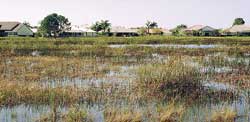 |
| Wetlands. (Photo courtesy of South Florida Water Management System) |
Federal agencies have proposed to revise requirements for what developers must do to make up for wetlands damaged or destroyed by construction projects. One result, agencies say, would be to encourage use of “mitigation banks.” These entities control preserved or newly created wetlands tracts and sell “credits” to builders to offset wetlands losses elsewhere. But the regulation also drew criticism from environmental groups.
Benjamin Grumbles, the Environmental Protection Agency’s assistant administrator for water, says the proposal, published March 28 in the Federal Register, “takes us to the next level” in wetlands conservation and restoration (see www.epa.gov/wetlandsmitigation). He says the rule, proposed by EPA and the Army Corps of Engineers, will speed the pace of restoring wetlands, increase accountability and provide “clear, results-oriented standards” for replacing lost tracts.
George Dunlop, Army deputy assistant secretary for civil works, says the new rule doesn’t affect the amount of required wetlands mitigation. He says it would be a shift away from the current “top down, one-size-fits-all” system.
“Clearly, everybody wants mitigation to be successful,” says Susan Asmus, a National Association of Home Builders staff vice president, adding that the proposal gives a preference to mitigation banking. “If this is getting us closer to being there, I think it’s a positive development.” But Melanie Shepherdson, a Natural Resources Defense Council staff attorney, says the proposal “does not protect water quality or wetlands.”
When developers seek a Clean Water Act Section 404 permit to dredge or fill wetlands, they must try to minimize or mitigate wetland losses, or when damage is unavoidable, compensate by building new wetlands, buying mitigation credits or paying fees.
A Corps-EPA information sheet says such compensatory mitigation now has varying standards and criteria: “The [new] rule establishes a single set of standards which all forms of compensation must satisfy that is based on better science, increased public participation and innovative market-based tools.”
Ed Hopkins, director of the Sierra Club environmental quality program, says, “We’re not convinced that the whole concept of compensating for lost wetlands by buying credits which may be far from the site of wetland losses is a good idea.”
“These regulations can improve the Section 404 program for all participants,” counters National Mitigation Banking Association President Craig Denisoff.

Post a comment to this article
Report Abusive Comment